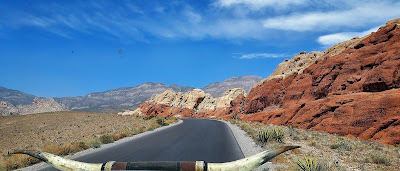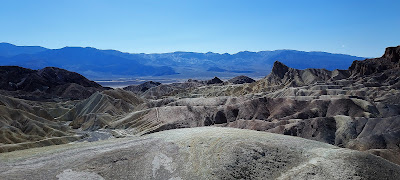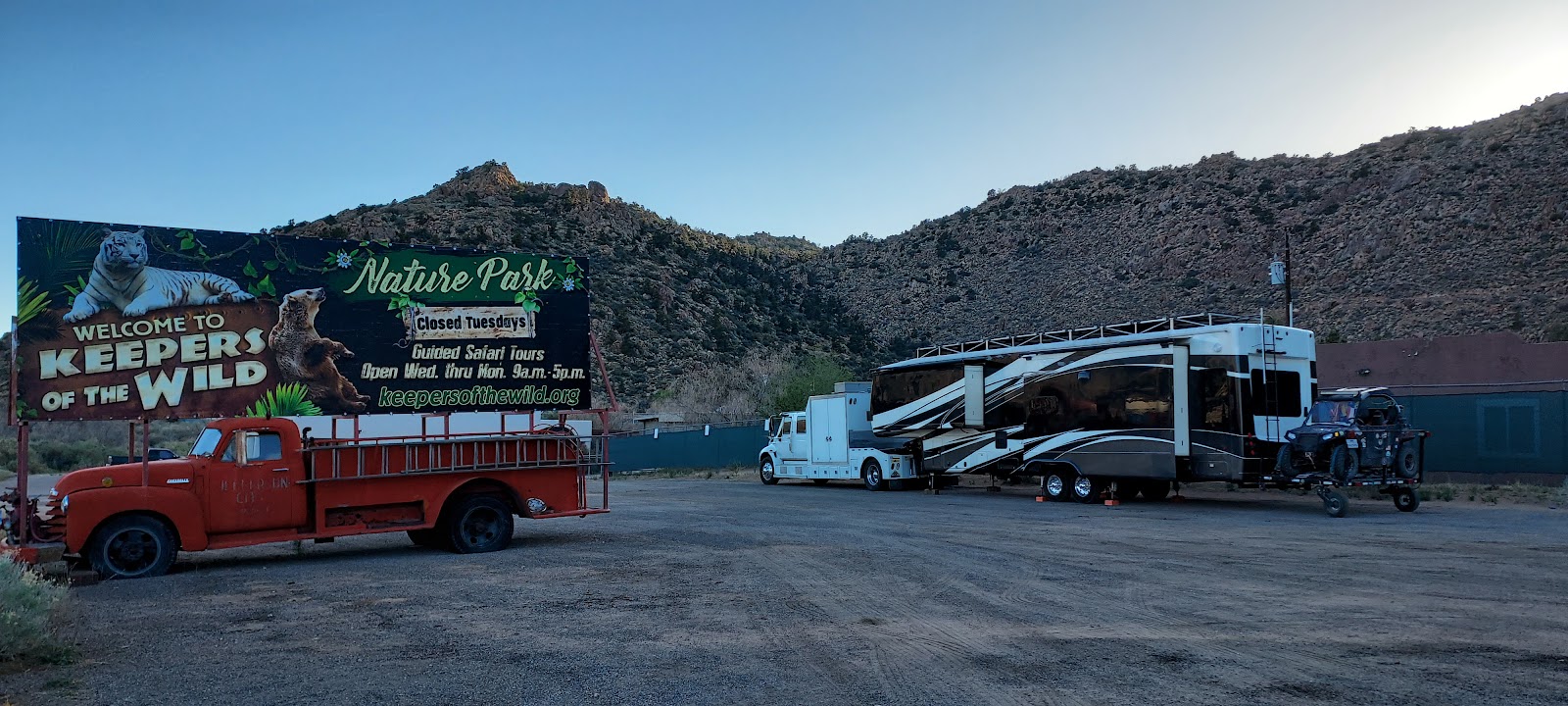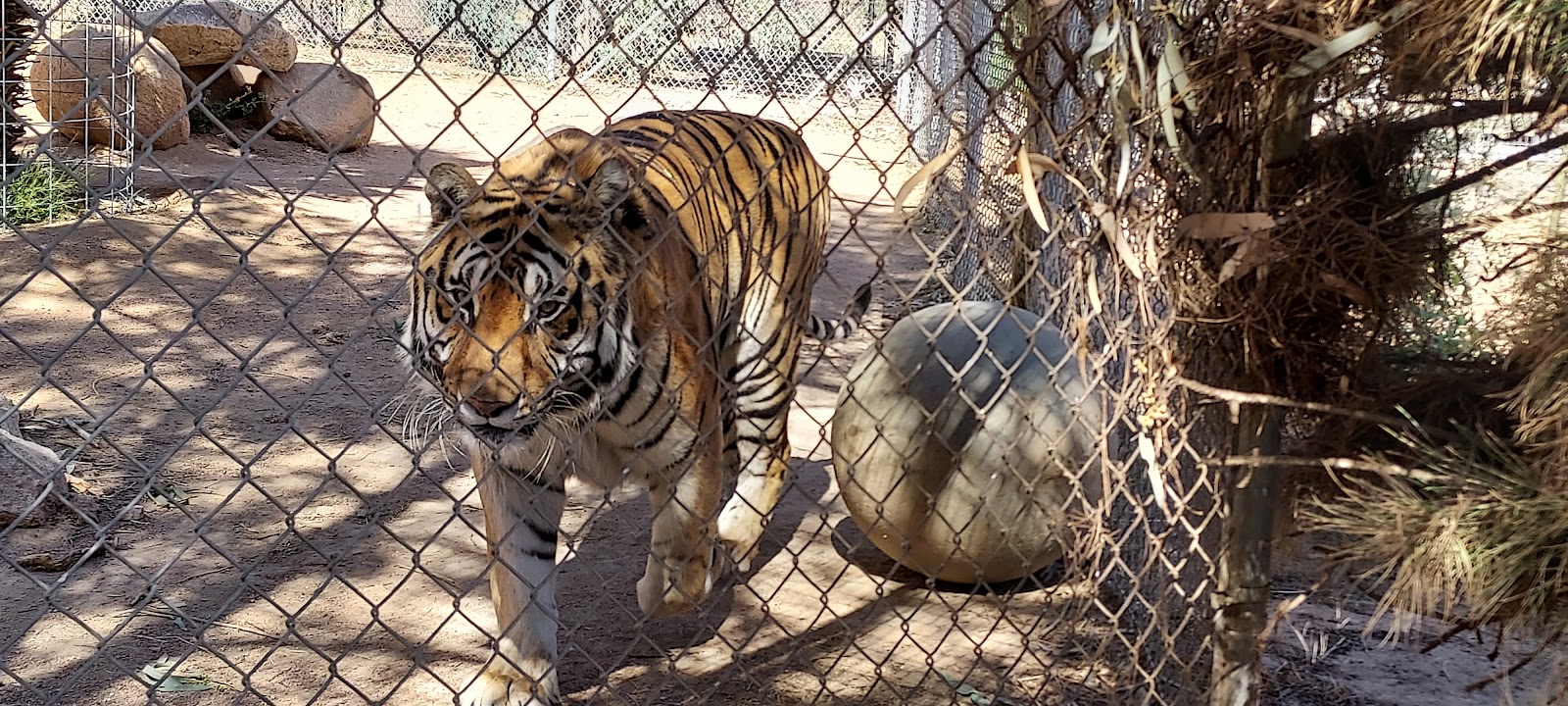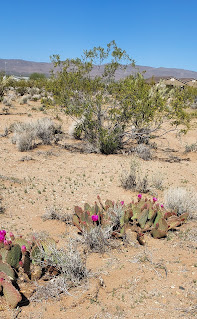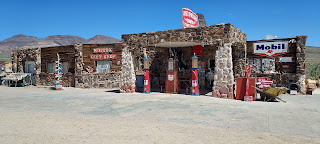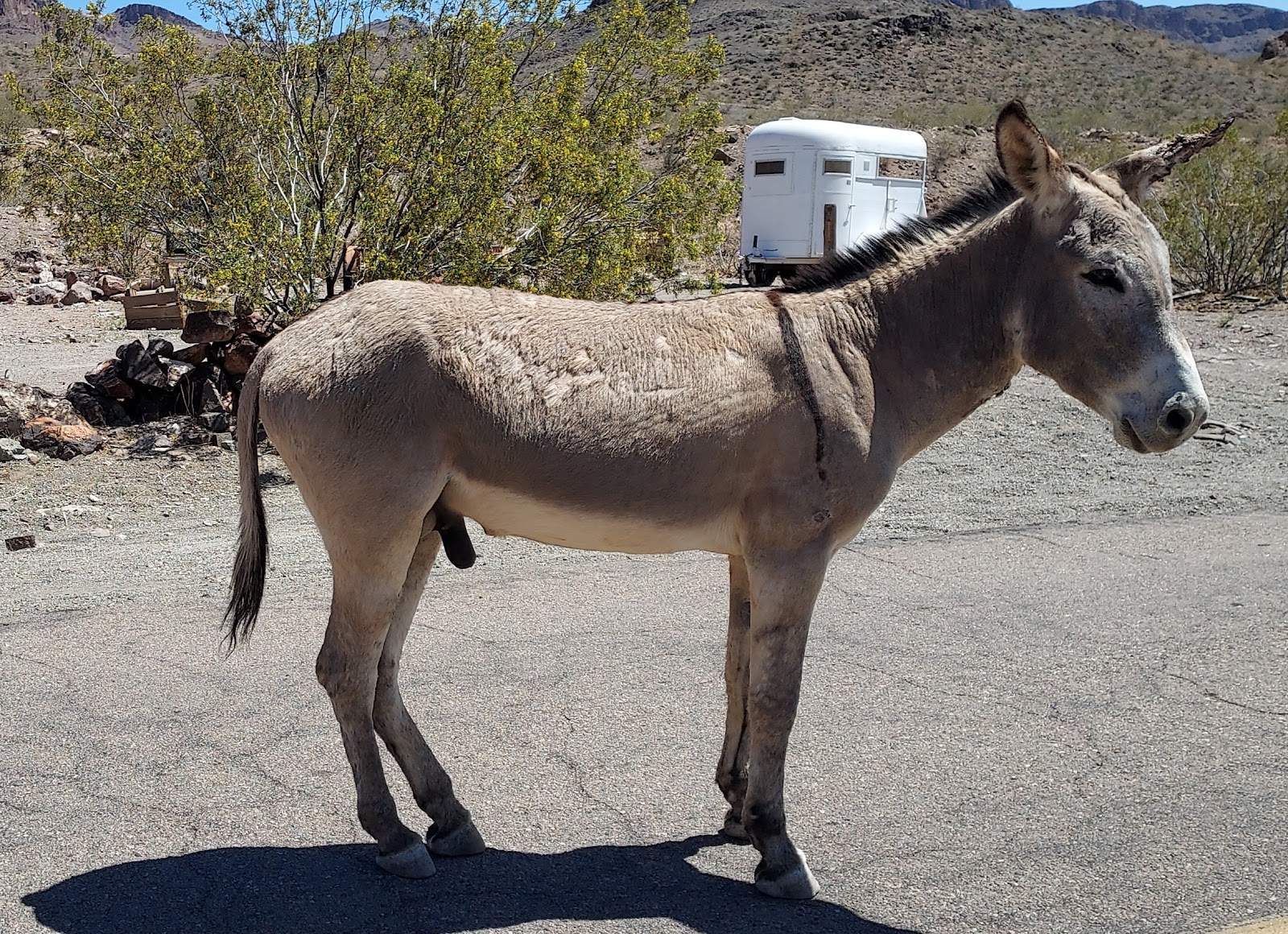We said our goodbyes to our wonderful Golden Valley, AZ Hip Camp Hosts Linda, Lawrence, and Max. Mom bestowed them with some home-baked goods to thank them for their hospitality. Then we hitched up Suite Retreat, loaded into Big Boomer, and drove to US-95 toward Las Vegas. Can’t believe how much Sin City has expanded and the suburban sprawl that has transpired since our last visit in 2017.
Soon we were at our next camping destination, Pair-A-Dice RV Park in Pahrump, NV. This is an Escapees Co-op, available only to Escapees members. Lot owners who are traveling put their lots into a rental pool, making them available for other Escapees members to utilize. It is a nice park, with wide, level gravel roads and long, pull-through sites. All the lots have sheds/casitas that in some instances have been converted to sunrooms. However, not all lot owners (like those of our assigned spot) give renters permission to utilize the structures. Still, the shed/casita provides privacy between each RV site. The Park does not accept reservations, so we boondocked the first night. Then we took advantage of their $75/week introductory offer for first time Escapees visitors. What a bargain! We pulled onto our assigned lot, which was decorated with Southwest motif lawn ornaments. There was a strange looking couple hanging around the property. I was a bit leery of them at first.
 |
| Yours truly with my new alien friends. |
After settling in, we did a quick tour of Pahrump. Once a ranching area, it is now an up-and-coming bedroom community following the course of Vegas’s growth, which is only 45 minutes away. Throughout Pahrump there are loads of land parcels available for purchase. Pahrump has plenty of medical professionals, pharmacies, cannabis dispensaries, and casinos. There is a Smith’s grocery store as well as a Walmart, where this stuffed rat noticed deep price increases from our last grocery replenishment. Pahrump even has a new saloon and dance hall, Rhinestones. We were patrons there several evenings during our week-long Pahrump visit for the free line dancing lessons and subsequent musical entertainment. In fact, we met up there twice with Mike, our buddy from Quartzsite dancing, who was in Pahrump volunteering with the Home on Wheels Alliance. It seems no matter where we are on the road, we are never far from a friend to share good times and fellowship.
The next day we used Big Boomer rather than Maximus the trike as transportation because of the heavy winds. Yup, gusts again (this time up to 65 miles per hour) seem to be following us on our route. We arrived at Red Rock Canyon National Conservation Area serviced by the Bureau of Land Management (BLM). At the time of our visit, BLM required advanced reservations to enter the site, which we made on-line earlier in the week. As always, we started our tour perusing the Visitor Center, from which we hiked the 2-mile Moenkopi Trail. The wildflowers were in bloom in this part of the Mojave Desert, the smallest desert within the U.S.A. Then we returned to Big Boomer to do the 13-mile Scenic Drive, giving us spectacular panoramic views of the colorful Calico Hills. We were lucky enough to find parking for Big Boomer at each point of interest, including the Sandstone Quarry and High Point Overlook, elevation 4,771 feet. Soon it was time to stretch our legs. So, we hiked the Willow Spring Loop, which brought us to the wall of petroglyphs. The Loop incorporated Lost Creek Trail, appropriately named since this Rambling RV Rat (and a few other folks, too) managed to go astray. We had a long, but wonderful day, clocking 5 miles, viewing the gorgeous rock formations, and earning yours truly another Junior Ranger badge.
The weather the next day was chilly and rainy, so Maximus stayed parked at our Pair-A-Dice site and we used Big Boomer to drive to Rhyolite to view the remains of an old Nevada gold mining town. This is an awesome place, with more original buildings standing than other ghost towns we have visited. I particularly enjoyed the glass bottle house, built circa 1905. The bottles, embedded within mortar, keep the interior of the house cool in the summer and warm in the winter.
We saw the faux grave of Miss Mona Bell, one of the entrepreneurial ladies from Rhyolite’s one-time “red light district”.
This town bustled in its heyday: 6,000 residents, 3 railroads, and multiple hotels and mercantiles. It boasted electric lights, phone lines, telegraph lines, and water mains. But by 1920, only 14 residents remained.
 |
| Train depot |
.jpg) |
| Remnants of the school, bank, and one of the mercantiles |
While in Rhyolite, we explored the Goldwell Open Air
Museum, a unique outdoor sculpture park.
Many of the creations represented ghouls, quite apropos for being
located within a ghost town. My favorite
was the replica of DaVinci’s Last Supper painting. Installed in 1984, the artist used human
models to make the life-sized ghost figures.
He wrapped the models in plaster-soaked fabric, then posed them
appropriately for the scene. When the
plaster dried, the models un-posed and the molded figures, later coated with
fiberglass, remained. Fascinating! The Goldwell Museum also included a vibrant mosaic
sofa art piece, which doubled as the location of a hidden geocache for us to
find and log. We chatted with the Museum
curator, admiring the beautiful photography that is exhibited there.
 |
| We walked around the labyrinth |
 |
| The Last Supper |
 |
| This colorful mosaic sofa doubled as a geocache location. |
 |
| A statue in honor of the area's most prominent prospector, Frank "Shorty" Harris. |
 |
| Lady Venus |
 |
| This ghost is into physical fitness! |
We stopped at the Red Barn Art Center, the Museum’s latest acquisition, located in Bullfrog Township, another former mining district right outside of Rhyolite. We visited the Rhyolite Cemetery, viewing the graves, many unmarked.
 |
| Nothing like viewing a desolate cemetery under dark, ominous clouds! |
Rhyolite, like Red Rock Canyon, is serviced by BLM. Hence, we found some folks camping in an area that offered solitude and scenery.
On our return to Pahrump, we stopped at the Museum and
Historical Society in Beatty, NV, which regrettably was closed for Earth
Day (go figure). But we picked up a brochure and
took the 10-cent self-guided walking tour to get a flavor for Beatty. I must admit I was intrigued by the 1905 root
cellar that was converted in 1953 to a chapel, especially when a young local
resident warned me the place was haunted!
I also enjoyed seeing the 1905 Rhyolite home of the Taylor family that
had been relocated to Beatty in 1925. Now it
is surrounded by the beautiful blooms of pomegrante trees. We found a couple of geocaches with the
assistance of some local residents.
 |
| A 1905 root cellar converted in 1953 to a chapel |
 |
| 1905 home of the Taylor Family, relocated from Rhyolite to Beatty |
 |
| Pomegrante blooms. |
 |
| Memorial Garden at the Local VFW |
 |
| Local boys Nester and Dominick lent some assistance to us in locating a geocache. |
On another day we hopped on Maximus early on a chilly 48F degree morning, heading to Death Valley National Park. By the time we arrived at Furnace Creek, it was a comfortable 76 degrees. After perusing the Visitor Center, watching the film, and picking up my Junior Ranger booklet, we fueled up before departing Furnace Creek. Holy Havarti Cheese--$8.15 for unleaded regular! This is why Dad despises coming to California!
Unfortunately, many roads within the Park were closed, including the one leading to Scotty’s Castle. Bummer! I really wanted to explore the Castle since we didn’t get there when we visited Death Valley many moons ago as a side trip from Vegas for my Grandma’s 70th birthday. Oh well, plenty of other stuff to see, especially those sites we didn’t visit on our prior trip. Hence, we went to Mesquite Flat Dunes. These dunes are not made of sand. Instead, they are tiny grains of quartz and feldspar. We hiked out with the aspiration to stand atop the very tallest dune. It was tricky finding the easiest route out, but we ventured on. Mom puttered out halfway up the second highest dune. She knew she could get up the dunes, but worried that getting down the highest one would be problematic. Dad and I persevered and achieved success in our mission.
 |
| The tragic destiny of a desert kangaroo rat. |
 |
| I made a self-portrait on the way up a dune. The winds of time had already altered it by the time we climbed down. |
 |
| Mom called it quits... |
We refueled Maximus in Stovepipe Village at the bargain price of $6.34 and then visited the Harmony Borax Works site. Borate ore was mined and processed into Borax starting in 1883. Soluble in water, Borax, AKA the “White Gold of the Desert”, is commonly used in industrial and household products. Once the plant was fully operational, Harmony produced 3 tons of Borax per day, utilizing a crew of 40 men. And they didn’t even work during the summer months because the intense heat interfered with the chemical crystallization process. Successfully producing Borax was one thing, transporting it out of the valley was another. But the 20-mule teams saved the day. 18 mules and 2 horses (to be precise) would pull 2 wagon loads of Borax and a 500-gallon tank of water—30+ tons in total—through the canyons to the nearest railroad, approximately 160 miles away. Fascinating! I am always amazed at the entrepreneurial spirit of the early pioneers.
Moreover, I would be remiss without crediting the peoples who roamed these lands as hunters nearly 10,000 years ago and the Timbisha Shoshone tribe who, adapting to their surroundings, inhabited the area 1,000+ years ago and continue to live on their sacred homelands.
Next up was Artist’s Palette, the 9-mile scenic drive named for the multi-colored rock formations. Then to Bad Water Basin, the driest, hottest, and--at nearly 300 feet below sea level--the lowest point in all the U.S.A. While the water tastes yucky with its high salt content, it actually is NOT poisonous. Though we visited these sites previously, they certainly warranted another viewing.
 |
| Artist's Palette |
 |
| Bad Water Basin |
 |
| That red spot represents sea level! |
On to Zabriskie Point to observe the Badlands of Death Valley.
Then to our final point, Dante’s View. In my humble opinion, this location is the crème de la crème of the Park. We ascended 13 miles to this viewpoint that is 5,475 feet above sea level to marvel at the breathtaking views of the entire valley. Simply spectacular!
We left Death Valley National Park, but had one final site
to see before returning to Pahrump: Amargosa Opera House at Death Valley Junction. The property was owned originally by Pacific
Coast Borax Company and housed its offices and workers’ quarters. The property was a mini town, complete with
doctors, post office, community center, even a hospital and morgue. Once Pacific Coast Borax Company moved
locations in the 1920s, they turned to tourism for the property. There was a hotel and café. The property changed owners numerous times
thereafter, with the community center building abandoned completely and left in
disarray. Enter the entertainer (actress,
dancer) Marta Becket in March 1967.
She and her husband stopped at a
local service station to have a tire fixed.
Yada, yada, yada, she had a vision, purchased the old community center
building, renovated it, and turned it into the non-profit Amargosa Opera House. Quite the talent, she spent 6 years painting
all the wall murals within the building.
The murals are awesome, containing characters from various operas and
some fun social messaging, like the nuns looking judgingly on the “ladies of
the evening” out for a night of culture.
Up until the age of 83, Marta performed ballet on this stage. At 85, she turned in her ballet slippers, but
performed other arts until her death in 2017 at the age of 92. Marta’s story is quite inspirational. It is a tale of following your dreams,
applying your given talents, persevering, and living each day to its fullest.
Well, I’m bushed from a busy but fun-filled week, so I’ll sign off now. Talk to you again soon!

